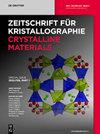Rb2Zn(TeO3)(CO3)·H2O和Na2Zn2Te4O11的有序无序(OD)结构
IF 2.7
4区 材料科学
Q3 CRYSTALLOGRAPHY
Zeitschrift Fur Kristallographie-Crystalline Materials
Pub Date : 2022-07-13
DOI:10.1515/zkri-2022-0030
引用次数: 4
摘要
摘要通过ZnO、TeO2、Rb2CO3(摩尔比2:3:6)和ZnO、TeO3、Na2CO3(摩尔比2:3:10)的混合物与少量水作为矿化剂反应,获得了两种碱金属氧化锌(IV)Rb2Zn(TeO3)(CO3)·H2O和Na2Zn2Te4O11的单晶。这两种化合物都以层的有序无序(OD)结构结晶,并具有较高的层错概率。Rb2Zn(TeO3)(CO3)·H2O的晶体结构由平行于(100)延伸的层组成。该结构由两种非极性OD层组成,分别由三角锥[TeO3]2−、四面体[ZnO4]6−、Rb1+和CO32-、H2O、Rb2+组成。层组的不同中心导致堆叠排列的模糊性。Na2Zn2Te4O11的晶体结构是由平行于(001)延伸的层构建的。三角锥[TeO3]2−和双酚[TeO4]4−多面体形成[Te4O11]6−基团,它们通过较长的Te-O接触连接,形成沿[100]或[010]取向的1∞[Te8O22]12−双链。这些链形成非极性层,它们交替出现在由四重旋转反转相关的两个方向上。Zn2+和Na+阳离子位于层界面处。堆叠的模糊性是由于相邻层的不同晶格造成的。本文章由计算机程序翻译,如有差异,请以英文原文为准。
Order-disorder (OD) structures of Rb2Zn(TeO3)(CO3)·H2O and Na2Zn2Te4O11
Abstract Single crystals of the two alkali metal zinc oxidotellurates(IV), Rb2Zn(TeO3)(CO3)·H2O and Na2Zn2Te4O11, were obtained by reactions of mixtures of ZnO, TeO2, Rb2CO3 (molar ratios 2:3:6) and ZnO, TeO2, Na2CO3 (molar ratios 2:3:10), respectively, with small amounts of water as a mineralizer. Both compounds crystallize as order-disorder (OD) structures of layers and feature a high stacking fault probability. The crystal structure of Rb2Zn(TeO3)(CO3)·H2O is composed of layers extending parallel to (100). The structure is composed of two kinds of non-polar OD layers consisting of trigonal-pyramidal [TeO3]2−, tetrahedral [ZnO4]6−, Rb1+, and CO32−, H2O, Rb2+, respectively. Different centrings of the layer groups lead to an ambiguity in the stacking arrangement. The crystal structure of Na2Zn2Te4O11 is built from layers extending parallel to (001). Trigonal-pyramidal [TeO3]2− and bisphenoidal [TeO4]4− polyhedra form [Te4O11]6− groups, which are connected by longer Te–O-contacts to form 1∞[Te8O22]12− double chains oriented along either [100] or [010]. These chains form non-polar layers, which appear alternatingly in two orientations related by a fourfold rotoinversion. The Zn2+ and Na+ cations are located at the layer interface. The stacking ambiguity is due to different lattices of adjacent layers.
求助全文
通过发布文献求助,成功后即可免费获取论文全文。
去求助
来源期刊

Zeitschrift Fur Kristallographie-Crystalline Materials
CRYSTALLOGRAPHY-
CiteScore
2.00
自引率
16.70%
发文量
55
期刊介绍:
Zeitschrift für Kristallographie – Crystalline Materials was founded in 1877 by Paul von Groth and is today one of the world’s oldest scientific journals. It offers a place for researchers to present results of their theoretical experimental crystallographic studies. The journal presents significant results on structures and on properties of organic/inorganic substances with crystalline character, periodically ordered, modulated or quasicrystalline on static and dynamic phenomena applying the various methods of diffraction, spectroscopy and microscopy.
 求助内容:
求助内容: 应助结果提醒方式:
应助结果提醒方式:


